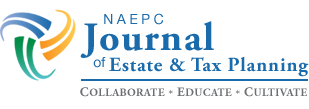NAEPC Webinars (See All):
Issue 47 – October, 2025
NAEPC Journal of Estate & Tax Planning
 Mavis N. McKenley, CTFA, AEP®, CFP®
Mavis N. McKenley, CTFA, AEP®, CFP®
AMG National Trust
Virginia Beach, VA 23462
Welcome to the Fall Edition of the NAEPC Journal. Fall always brings feelings of warmth and comfort as we head into the Holiday Season. We also tend to start thinking about the New Year and reflect on the planning discussions we neglected to tackle because answering those difficult questions was just too hard. Year after year we keep moving planning decisions to the bottom of our To Do list.
As practitioners in the estate planning community, this is our time to shine. We help our clients put planning back to the top of the list to bring peace of mind to their families and loved ones. This is what we do best and in our latest edition of the journal we continue to provide you with tools, research, and educational articles that will keep you relevant and forward thinking in your practice.
I want to thank the many volunteers that serve on the Publication Committee for another successful issue. A special thank you to our Co-Editor Katherine Sheehan for all of her time and effort in getting us over the finish line once again. I hope you all enjoy this Fall edition, and I hope you will visit with us at our annual NAEPC conference which is taking place this week at the Gaylord National Resort & Conventions Center.
We truly appreciate your support.
As a reminder if you are looking to publish, please reach out to editor@naepcjournal.org.
Publish your own original article in the NAEPC Journal!
We are always in search of original articles related to the profession of estate planning and disciplines within and are now collecting content for the next issue. Submissions are invited from estate planning professionals, estate planning council members, and Accredited Estate Planner® designees.
Click on the link above to learn more.
Features
The Future Practice of Estate Planning: Gamification of Data Gathering
In an era of self-driving automobiles and computer applications able to synthesize terabytes of information in a matter of seconds, why are paper forms or static electronic versions of the same still employed to collect estate planning data from clients? As we enter the artificial intelligence (AI) age, isn’t it time to enhance the client experience during the data collection process? Let us be transformative in the way firms interact with clients in the collection and use of their information..
Author: Harvey A. Hutchinson III, JD, LL.M. (taxation), CFP®, AEP®
Three Estate Planning Pictures Worth Thousands of Words
In this article, I present three good pictures, i.e., models that view estate planning from 30,000 feet and explain it in concept and theory. Possessing zero artistic skill, I then had a graphic design artist put each in graphic form. In this piece, I highlight purposeful planning wisdom from the models that I hope you will find useful in your estate planning work for clients and their families..
Author: L. Paul Hood, Jr., JD, LL.M., CFRE, FCEP
IRS Continues to Attack Trust Modifications: Revisiting CCA 202352018 Following McDougall v. Commissioner
In McDougall v. Commissioner, the Tax Court applied the “change in economic position” analysis present in IRS Chief Counsel Advice memorandum 202352018. The court’s analysis suggests that the Chief Counsel’s reasoning was largely sound, albeit incomplete. Advisors should judiciously consider how (and whether) to modify irrevocable trusts now that the IRS has additional authority to attack those modifications.
Author: Scott W. Maselli
Why Older Attorneys Without Adequate Retirement Savings Use Cash Balance Plans to Create Exit Strategies Without Selling Their Business
For seasoned attorneys who find themselves behind on retirement savings, cash balance plans offer a powerful alternative to traditional exit strategies. This document explores how these specialized pension plans enable legal professionals to rapidly build multi-million dollar retirement funds while enjoying significant tax advantages all without the uncertainty and complications of selling their practice.
Author: David Swanson
Managing Aging Clients Real Life and Practice Management
Making financial decisions takes time, attention, and energy at any age. For the aging population, it may become increasingly difficult for them to manage their finances, particularly if their health is declining or they are experiencing cognitive issues. You may have clients you started working with in their forties and fifties who are now in their seventies and eighties, and their focus has now shifted to their longevity and their legacy.
Authors: Bronwyn L. Martin, MBA, ChFC®, CLU®, CLTC®, CRPC®, CFS®, CMFC®, AEP®, LACP, AIF® and Rebecca Roskey-Brunner, BSN, RN, CEN, CMC
Options to Prevent a Connelly Outcome
The 2024 decision from the United States Supreme Court in Connelly v. United States upended buy-sell planning for many closely held businesses. With proper planning, there are several ways a buy-sell agreement can be drafted and implemented, that might avoid a repeat of Connelly. Time alone will tell, but one can hope that Connelly will one day be merely a curiosity in the history of business valuation and buy-sell agreement planning.
Author: April Caudill, JD, CLU®, ChFC®, AEP® (Distinguished)
Understanding Probate Bonds in Estate Administration
Probate bonds are often required when someone is appointed to manage an estate or care for another person. This article explains why probate bonds matter, when they are needed, how they work, and what estate planners should know to help clients avoid unnecessary delays and complications.
Authors: Phil Pavarini and Christian Carson, JD
From QTIP to Gift Tax: Understanding Anenberg and McDougall’s Impact on Estate Planning
A Qualified Terminable Interest Property (“QTIP”) trust is a type of trust often used to provide for a surviving spouse while allowing the decedent to control the ultimate distribution of assets following the surviving spouse’s death. A QTIP trust can provide significant benefits, such as deferral of the estate tax, flexibility in asset distribution and control over distributions.
Author: Kathi L. Ayers, Esq.
Overfunded 529 Plans – Solutions During Life & Treatment at Death
Section 529 of the Internal Revenue Code allowed for the establishment of Qualified Tuition Programs as a tax advantageous method by which individuals could save and invest money to be used for a child or other family member’s future educational expenses. As more individuals establish such accounts due to the tax advantages, it follows that an increasing number of individuals encounter issues relating to such plans,
Author: Dominik Gutowski, JD
Planting Seeds for Evergreen Charitable Planning
There is no time like the present to start planning, but there are prudent, and evergreen, ways to integrate charitable giving strategies into holistic planning for every age and stage of life. This article provides an overview of key considerations for charitable planning that will last a lifetime and beyond.
Author: Jan L. Lane, CAP®
Non-Grantor Trusts for State Resident-Beneficiaries to Avoid Income Tax
This Article provides a practical guide for legal practitioners who wish to use a non-grantor self-settled trust for the purpose of avoiding state income taxes imposed by high-tax jurisdictions on resident grantors. Although this Article is specific to California state income taxes and uses Nevada incomplete gift non-grantor trusts to illustrate the concept, the principles discussed are applicable to other jurisdictions. This Article addresses whether or not the state of California may come after the trust for the payment of state income taxes on those gains not yet distributed to the grantor-beneficiary
Author: Shanee Cohen, JD
Medicare Facts: Challenging Myths and Preventing Common Mistakes
When it comes to Medicare, facts matter. No opinions, no embellishments, just clear, accurate information. Even “facts” can be misinterpreted or misused, leading to costly mistakes. The challenge is knowing which details you can rely on, and which ones may be misleading. As you approach Medicare eligibility, verifying the details and applying careful analysis is essential. This article will help to clear up some common myths so you can avoid costly mistakes.
Author: Dianne Savastano
The Essential Role of Qualified Personal Property Appraisers in Estate and Donation Valuations
When an estate requires an appraisal, it is crucial to engage the appropriate expert for high value personal property. This includes fine art, jewelry, antiques, high-value rugs, wine, furniture, silver, rare manuscripts, antiquities, ethnographic art, coins, and memorabilia.
Author: Christian Trabue
Understanding Probate Bonds in Estate Administration
Probate bonds are often required when someone is appointed to manage an estate or care for another person. This article explains why probate bonds matter, when they are needed, how they work, and what estate planners should know to help clients avoid unnecessary delays and complications.
Authors: Phil Pavarini and Christian Carson, JD
How Mere Hours Can Cost Millions: Survivorship Presumptions and Estates
Celebrity deaths serve as a reminder of estate planning principles that may apply to ordinary individuals and situations. Hackman’s estate plan underscores how an insignificant clause—or the absence of one—can dramatically alter the distribution of one’s assets at death. A simple survivorship provision could have provided clarity
Author: Sarah E. Brownlow, JD
Rethinking and Repurposing Life Insurance: Enhancing Estate Planning with Retained Death Benefit Strategies
Life insurance has long served as a foundational tool in estate and business planning. However, today’s high-net-worth (HNW) clients face evolving dynamics and ever-changing challenges, including an uncertain interest rate environment, persistent inflation concerns, global economic fluctuations, and legislative changes such as the Tax Cuts and Jobs Act of 2017 and the recent One Big Beautiful Bill Act. The latter not only increased federal estate tax exemptions but also made those expanded exemption amounts permanent.
Authors: Jim Dodaro and Scott Etish
What Really Drives Life Insurance Sales?
This article will discuss the variation in the sales of distinct types of life insurance over the past five decades and analyzes what is behind the back-and-forth swing in market share. The author has gathered all available data on sales of permanent life insurance and visually represents it in concert with what is concurrently happening in the financial markets to shed light on the often overlooked influence of market trends on life insurance choices. The goal is to provide insights that can help policy owners and advisors make more informed decisions in creating a life insurance portfolio that aligns with their best interests.
Author: William J. Boersma, CLU®, LIC, AEP®
Designing a Private Decanting Power
For sommeliers, “decanting” means pouring wine from its bottle into a decanter to separate the sediment and aerate the wine, enhancing its flavor and aroma. For estate planners, “decanting” means distributing trust assets from one trust to another, typically to discard provisions that have aged poorly (e.g., mandatory payouts at a set age) and to enhance the provisions of the trust with new, modern features (e.g., to implement a state’s new directed trust statute).
Authors: Tony Ray Meyer-Mangione, JD and Beatrice Caplan, LL.M.
News Nook: A Compendium of Current Affairs
NAEPC Monthly Technical Newsletter
Reproduced courtesy of Leimberg Information Services, Inc. (LISI)

